What are warts? In an article written by a dermatologist with 37 years of experience, we will analyze the causes, diagnosis and treatment methods.

Disease description. Causes of the disease
Wartsare benign skin lesions with irregular light body in the form of excessive growth localized with papules (nodules) or plaques in the upper layer of the skin (epidermis).
The prevalence of warts in adults is 7-12% - up to 10-20% in school-age children.
Warts are very similar to other skin growths. Often, a person cannot accurately determine the disease on their own, so a dermatologist should be consulted to make a diagnosis.
Human papilloma virus is the cause of warts. The type of virus affects the type of warts that may develop. Therefore, each type of human papillomavirus infects tissue at the most characteristic localization.
| HPV type | Preferred localization |
Wart types |
|---|---|---|
| 1 | Feet, knees, palms, hands, fingers |
Plantar and palmar warts rarely simple warts |
| 2, 4 | Hands, fingers, knees, less often - feet |
Simple warts sometimes plantar, palmar and mosaic warts |
| 3, 10 | Legs, hands, face | Flat warts |
| 7 | Hands, fingers | Butcher's Warts |
| 5, 8, 9, 12, 14, 15, 17, 19-24 |
Face, arms, front body |
Epidermodysplasia verruciform |
Virus infection usually occurs through contact - direct contact between infected and healthy skin (for example, when shaking hands) or indirectly (through handrails, toys, etc. ). Therefore, it is possible to become infected with the human papilloma virus, which causes warts, in various places - public transport, school, work, home, high-contact and humid environments (swimming pools, saunas, gyms). In addition to skin inflammation, minor trauma to the epidermis where viruses enter, contributes to the infection.
Also contributes to the appearance of warts:
- immunodeficiencies (including HIV infection);
- hot and humid environment;
- The need for professional communication with meat and fish ("butcher warts").
Some types of human papillomavirus are transmitted from parents.
However, frogs and frogs cannot be infected, despite the horror stories we often fear in childhood - this is one of the most popular myths that have no basis for this disease.
If you find similar symptoms, consult your doctor. Do not self-medicate - it's dangerous for your health!
Wart symptoms
Symptoms will vary depending on the type of wart.
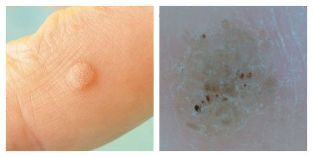
Common wart:
- Normal colored round dense papule 1-10 mm and larger.
- The surface of the papule is covered with cracks, layers.
- If the papule is on the finger, the pressure is lost and distorted. The same is true for palm drawing.
- Simple warts are found either individually or in several fragments - usually occur at the places of the largest injury (hands, fingers, knees).
- When viewed through a dermatoscope, the doctor can see small brown dots - thrombosed (clogged) capillaries. Patients often refer to these points as "roots". This is the main sign for a doctor: it can be used by a dermatologist to distinguish a wart from other similar diseases (for example, molluscum contagiosum and keratoma).
Plantar (horny) wart:
- The main symptom that usually causes a patient to see a doctor is pain when pressing and walking.
- These types of warts are usually localized on the feet.
- When you consult a doctor, as a rule, a keratinized, uneven plaque of normal color can be seen, but at the initial stage you can see a flat, smooth papule. With keratinization, capillaries can only be seen if the keratinized layer of the skin is removed.
- The base's shell is broken.
- Plantar warts are usually solitary, but there are also 2-6 warts;
- These warts are often confused with corn (especially dry) - this is the description of the problem patients often come to see.
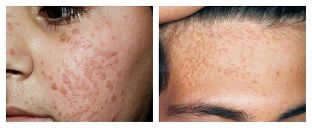
Flat (juvenile) wart:
- It looks like a normal, pink or brownish round, clear, smooth papule of 1-5 mm in size.
- Appears on hands, shins and very often on the face.
- There are always a few such warts - they are found in groups.
Epidermodysplasia verruciform (senile wart):
- Large, round, multiple conjoined neoplasms of normal, pink or brown color.
- It is most commonly seen in front of the face, arms and torso.
- Can be confused with keratoma, shingles and skin cancer.
Wart pathogenesis
Once the human papillomavirus enters the body, it can remain latent for a long time - a person is often unaware of its existence. When factors suitable for the virus emerge, it begins to "proliferate" in the epithelium, causing tissue changes.
Unlike other viruses, the human papilloma virus does not destroy epithelial cells - they naturally die on their own in the process of keratinization and scaling.
Local factors and the state of the immune system affect the spread of the infection. For example, people who have HIV infection or kidney transplant are more likely to develop warts. Moreover, these neoplasms are often difficult to treat. With normal immunity, the virus does not affect the deep layers of the skin, so many people get warts on their own after a few months.
The main stage in the emergence of warts is the acceleration of cell division and growth rate with the help of the virus. This rapid metabolism causes thickening of the skin layers. A tubercle called a wart appears because the tissues grow in a specific, small area.
Classification and development stages of the wart
There is no generally accepted classification of warts. However, there are several common varieties:
- Common wartis the most common type (70% of warts are just them). Such neoplasms are not felt and only cause aesthetic discomfort to the person.
- Plantar wart- appears on the soles of the feet, is painful, therefore requires treatment. Skin trauma caused by uncomfortable, tight, wearing shoes contributes to the development of such a wart.
- Flat warts- mostly seen in teenagers, adolescents. This is due to the imbalanced hormonal background of the youth, which affects the whole body. Usually flat warts are almost invisible.
- Senile warts- typical seniors. They usually appear on the part of the body covered with clothing, but can also occur on the face and hands. If there is no discomfort, such warts should not be treated - due to slow metabolism, recovery in the elderly may be much slower than in younger people.
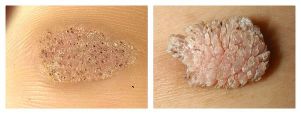
Other authors distinguish a few more of these wart types:
- Mosaic warts(HPV 2, 4) - neoplasms on the palms and soles. They look like foci of hyperkeratosis, that is, thickening of the stratum corneum (usually in the forefoot), covered with deep cracks.
- Cystic warts(HPV 60) is a very rare type of neoplasm in the foot. It is a cracked soft knot. When it opens, a white-yellow discharge like curd appears.
- Filiform wartsare thin and upright growths near the mouth, nose or eyes.
- "Butchers" warts(HPV 7) - appear on the hands and fingers of people who are in constant contact with meat and fish. Presented as cauliflower-like hypertrophic neoplasms, but of normal color.
In addition, types of warts are distinguished by their location.
So, anogenital warts - tumor-like neoplasms that occur on the genitals (especially where the skin passes into the mucous membrane) is a common disease. It is usually caused by HPV types 6 and 11.
Wart complications
The main reason why wart patients go to a doctor is an aesthetic defect that can affect the patient's quality of life, self-confidence and develop many complexes. Complications can also include cracking of the wart surface and the addition of infection, and some types of warts may include pain when walking.
Skin warts do not usually develop into malignant neoplasms, they are quite harmless, but in very rare cases, such a complication can still occur in immunocompromised individuals.
Other complications arise when trying to remove neoplasms on their own. In this regard, inflammation and aesthetic defects in the form of scars can occur, as well as further spread of the virus to the skin, therefore, the morning after self-removal of a wart, a person may wake up with several new ones.
Remember that under the guise of a wart, a completely different disease can be hidden that cannot be detected without the advice of an experienced doctor.
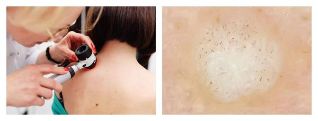
Wart diagnosis
Examination (clinical picture) and anamnesis (medical history) are usually sufficient to make a diagnosis.
To confirm the diagnosis, the doctor may perform a histological examination - examination of the neoplasm cells.
Differential diagnosis is very important to distinguish warts from other diseases. For example,common wartsshould be distinguished from the following diseases:
- Molluscum contagiosum- occurs more often on the body and genitals, less frequently on the hands and feet. It is a hemisphere with a print on the surface; Pressed on the sides reveals a whitish "oatmeal".
- Epidermal verrucous nevus- usually alone, present from a person's birth. It usually rises above the skin surface covered with hair.
- Basalioma- a tumor in the form of a nodule cylinder covered with a crust in the center. Typical for the elderly.
Palmar-plantar wartsshould be distinguished from the following diseases:
- Keratoderma- large areas of keratinization and skin inflammation. No clotted capillaries.
- Palmar-plantar syphilides- multiple painless neoplasms, exfoliate around the skin. Syphilis has a positive reaction
- Corn- usually painless, can only cause pain when pressed vertically.
The doctor should also distinguish other types of wart from a range of diseases. If another pathology is suspected, he may recommend additional diagnostics (for example, detection of antibodies to viruses, CT or MRI).
Wart treatment
Warts are treated for aesthetic purposes and improve the patient's quality of life. It can only be prescribed by a doctor after an examination and correct diagnosis. Independent attempts to get rid of a wart are unacceptable, as a patient without medical training and the necessary equipment cannot fully identify the disease and complications after such "treatment" occur much more often than recovery.
There are several ways to treat warts. All are usually done under the supervision of a doctor, and some - only in the treatment room of the clinic.
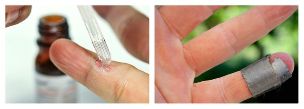
Chemical Treatment
Milk salicylic collodion and salicylic patches are used to get rid of the wart. The percentage of drugs and the mode of use (long-term patch use, applications, etc. ) depend on the extent and localization of the neoplasm.
Zinc and 2-chloropropionic acid solutions can also be used. In this case, a chemical composition is applied to the pre-treated surface, which remains on the wart until the color changes (depending on the type of wart). The process is repeated several times after 7, 14 and 21 days. Before each procedure, the tissue is removed mechanically.
Another chemical method is a combination of nitric, acetic, oxalic, lactic acids and copper nitrate trihydrate. In this way, only relatively small neoplasms are treated - up to 5 mm. The solution is also allowed to change the color of the wart. After 3-5 days, the patient comes to the follow-up appointment, if necessary a second procedure is prescribed within 1-4 weeks.
Cryodestruction
This method involves freezing the wart with liquid nitrogen: the moistened tampon is pressed against the damaged skin (with a few mm of surrounding tissue caught) for 1-5 minutes. More than one treatment is required every four weeks to eliminate some lesions.
The main disadvantages ofCryodestruction are its painful and delayed effect compared to other methods; where only one procedure is usually sufficient to extract
Electrocoagulation
Under the influence of an electric current, the wart is removed in layers. Such an operation is performed under local anesthesia.
This method is more effective than cryodestruction, but has a significant drawback: electrocautery often leaves scars at the wart removal site.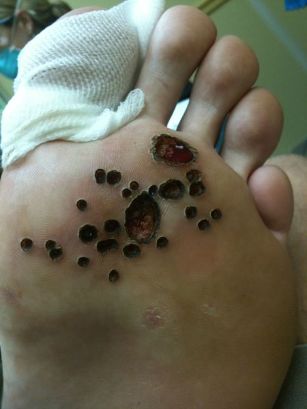 this method will not be the most suitable for patients who want to correct a cosmetic defect.
this method will not be the most suitable for patients who want to correct a cosmetic defect.
Laser destruction
The laser also removes warts in layers. The light guide contacts the skin for a few seconds to three minutes, depending on the size. Then the resulting scab is excised and the base of the wound is treated with laser again. The patient is then instructed on how to use the wound. The operation itself is performed under the influence of local anesthesia.
Radyowave Surgery
Radio wave surgery is one of the most modern and sensitive methods of removing some benign neoplasms, including warts.
The method is based on the generation of electromagnetic waves with different frequencies: from 100 kHz to 105 MHz. During the procedure, the tissues resist the passing waves, so molecular energy is released in the cells and the skin is heated. Under the influence of heat, cells really evaporate - a smooth cut is achieved. At the same time, no mechanical force is exerted on the affected tissue.
Advantages of this method:
- security;
- fast wound healing;
- good cosmetic effect - scars and scars are excluded;
- relative painlessness - local anesthetic administered before mini surgery;
- excluding secondary infection due to automatic disinfection of the electrode when the device is turned on.
The effectiveness of this method is recognized all over the world, but it is very difficult to find a clinic using the radio wave surgery method.
Which treatment method to choose
All of the above methods have several disadvantages:
- In the first few weeks, the operated area does not look attractive - crusts, darkening of the tissues. This should be considered if the warts are on visible parts of the body (for example, on the face).
- Unpleasant smell and some degree of pain during surgery.
In addition, each of these methods has contraindications, you need to learn them in a preliminary consultation with a dermatologist.
But the main disadvantageis that there is a high probability of recurrence, especially if warts are common and common. With each of these methods, doctors have been fighting the consequences, not the root cause, of the disease ever since.human papilloma virus cannot be cured.
Therefore, therapy is directed to:
- or destruction of neoplasms occurring in the entry site of the virus;
- to stimulate an antiviral immune response;
- or a combination of these approaches.
Often destructive treatment methods are used. Its efficiency reaches 50-80%.
Childhood is generally not a contraindication to surgical treatments. For this reason, most of them (including radio wave surgery) are also used to treat warts in children. An exception is the chemical removal of warts due to the possibility of an adverse reaction to the substance.
What to do after the procedure
Make sure you follow your doctor's advice after any of these procedures.
After removal of the tumor by any of the methods presented, the doctor usually prescribes treatment of the removal site. It is forbidden to remove the "scabs" yourself, soak the wound and expose it to direct sunlight.
If a patient is constantly suffering from warts, then he should consult an immunologist - this may require drug therapy that will increase the resistance of the immunity to the manifestations of the human papilloma virus.
Prediction. Prevention
If the patient is not immunocompromised, the warts may go away by themselves, but this will take a long time - from a few months to several years. Thus, in 65% of cases, warts regress independently within two years. If the wart is still in place after two years, removal is recommended. It is recommended to remove multiple enlargements immediately.
With normal immunity and a properly selected method of destruction (depending on the size and type of the wart) it is possible to remove pathogenic tissue and achieve a good cosmetic effect. Human papilloma virus remaining in the body with reduced immunity and other susceptibility factors cause relapses.
There is no specific disease prevention. But is infection so inevitable?
You can reduce the chance of a virus if you follow a few rules:
- Avoid walking barefoot in public places (swimming pools, public showers, gyms) where there is a possibility of skin injury and virus infection.
- Choose quality shoes, change them often. Try to keep your feet dry. Heat and moisture are excellent breeding grounds for human papilloma virus.
- To prevent periungual warts, only go to a certified nail technician and make sure they use sterile instruments.
For the prevention of anogenital warts, a tetravalent vaccine against the human papilloma virus is also highly effective, according to WHO (World Health Organization). There is currently no vaccine available to prevent other types of warts.
If you find a wart, do not try to cut, cut, or tear it off yourself - this way you can contribute to inflammation and further spread of the virus on the skin. After such a "removal" process, you can wake up in the morning with ten warts instead of one.














































































